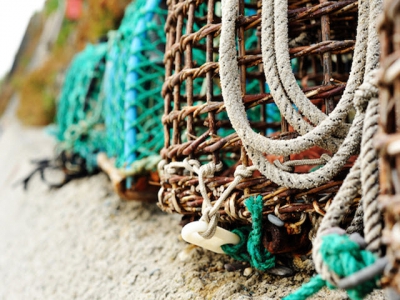Derelict fishing gear removal has major economic benefit for fisheries

A new study by researchers at William & Mary's Virginia Institute of Marine Science shows that removal of derelict fishing gear could generate millions of dollars in extra harvest value for commercial fisheries worldwide.
The study focused on a six year, collaborative program to remove derelict crab pots from Chesapeake Bay, showing that the effort generated more than $20 million in harvest value for area watermen.
Extending their methodology to estimate the economic benefits of removing derelict crab pots and lobster traps on a global basis, the researchers showed that removal of even 10 per cent of derelict pots and traps from major crustacean fisheries - the percentage of the Bay's derelict pots they estimate were removed by the VIMS program - could increase landings by 293,929 metric tons, at a value of $831 million annually.
The study, co-authored by VIMS professors Andrew Scheld, Donna Bilkovic, and Kirk Havens, appeared in Scientific Reports. The research was supported by NOAA' s Marine Debris Program.
Scheld, an assistant professor at VIMS, says "it's well known that derelict fishing gear can harm the environment and increase crab mortality, but the economic impacts of this 'ghost fishing' have rarely been quantified. Our study shows that VIMS' collaborative efforts to remove ghost crab pots from the lower Bay led to an additional 13,504 metric tons in harvest valued at $21.3 million - a 27 per cent increase above that which would have occurred had the pots stayed in place."
The effort to find and remove derelict crab pots from lower-Bay waters ran from 2008 to 2014. Led by Bilkovic and Havens, the program was unique in that it employed commercial crabbers to find and remove derelict gear during their winter closed-fishing seasons. Crabbers lose pots to storms, boat propellers, and other causes.
"All told," says Havens, "the crabbers removed 34,408 derelict crab pots during the program's six-year run. At the same time, harvests and gear efficiency were observed to increase dramatically."
The authors attribute the harvest gains to reduced competition from derelict pots. Says Scheld, "Derelict gear can distract or deter a crab from an active pot nearby, lowering the catch of watermen and damaging the commercial fishery."
"We estimate that crabbers harvested about 60 million more crabs due to the ghost-pot removals," says Bilkovic. "That's one extra blue crab each time a pot is retrieved--crabs that would have otherwise been captured or attracted to the now absent derelict gear."
The scientists conducted the study by modeling and comparing crab harvests with and without the removal of derelict pots within 54 fishery-management areas in lower Chesapeake Bay. Their harvest model used data on crabbing effort provided by the Virginia Marine Resources Commission, and stock abundance from the VIMS Winter Blue Crab Dredge Survey. The researchers converted the calculated harvest numbers to monetary values using the average annual dock price for hard-shell crabs in 2014 dollars.
Recognizing that derelict gear is a problem that extends far beyond Chesapeake Bay, the researchers extended their methodology to estimate the economic benefits of removing derelict crab pots and lobster traps on a global basis. They also note that the benefits of removing derelict gear likely extend to other fisheries.
"Lost trammel-nets, gillnets, long-lines, and bottom-trawling gear pollutes marine environments around the world," say Havens.
Adds Scheld: "This gear attracts target and non-target fishes in much the same way as ghost pots attract crabs, and its removal would likely generate economic benefits similar to those found for blue crabs in Chesapeake Bay."
Return on Investment
The program to remove derelict crab pots from lower Chesapeake Bay was paid for through disaster-relief funds made available in 2008 when the US Department of Commerce declared the Bay's blue crab industry a "commercial fishery failure" following many years of declining harvests.
The researcher's analysis shows that the program was a sound investment, with its $4.2 million price tag over 6 years easily recouped by the extra $21.3 million in blue crab revenues earned during that time. "The benefits far outweighed the program's total cost," says Scheld.
Their study also showed that return on investment could be enhanced further by targeting removal efforts on the most heavily fished sites, where lost gear is most likely to accumulate.
"We found that removing only 10 per cent of the pots taken during the actual program, if those efforts were focused on the 10 most-fished sites, would have increased blue crab harvests by 8,144 metric tons, or about 60 per cent of the benefit we saw from the full removal program," says Scheld.
"Ensuring both that crab pots have biodegradable escape mechanisms and that removal efforts target areas of highest fishing pressure are likely to yield benefits superior to any single strategy alone," says Scheld.
They caution that the net benefits of removal programs will ultimately depend on removal costs, which may vary widely by fishery.
Related news
 How to handle fishing gear responsibly
How to handle fishing gear responsibly A new scheme has been launched on the south coast of England to recycle old fishing nets and fishing gear to prevent it from going to landfill or from being
 Japanese conglomerate acquires 35 percent of Vietnamese shrimp company
Japanese conglomerate acquires 35 percent of Vietnamese shrimp company Mitsui & Co. has struck a $150 million deal to acquire a 35.1 percent stake in Minh Phu Seafood JSC.
 Helping small scale farmers gain certification
Helping small scale farmers gain certification A new programme designed to help small aquaculture producers apply for sustainability certification has been launched in Vietnam today.